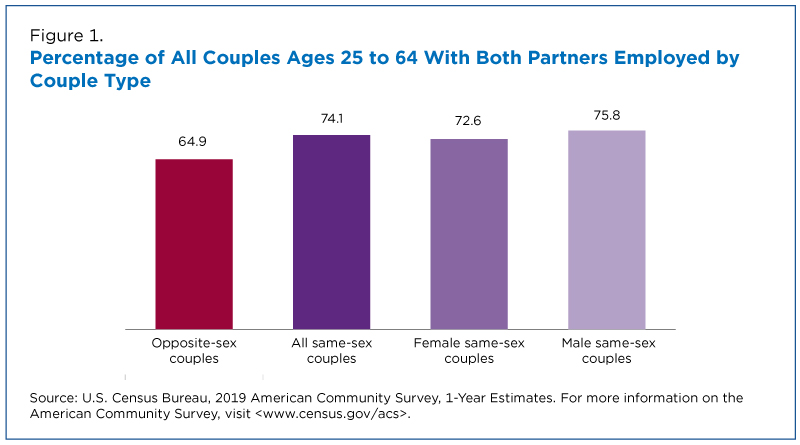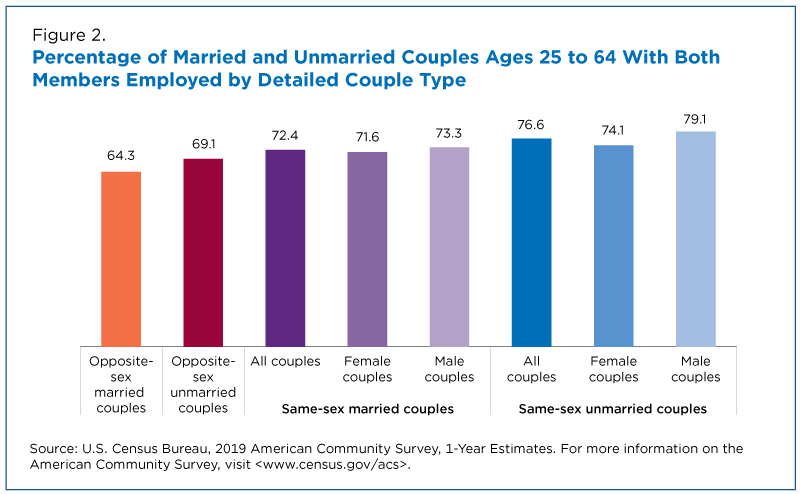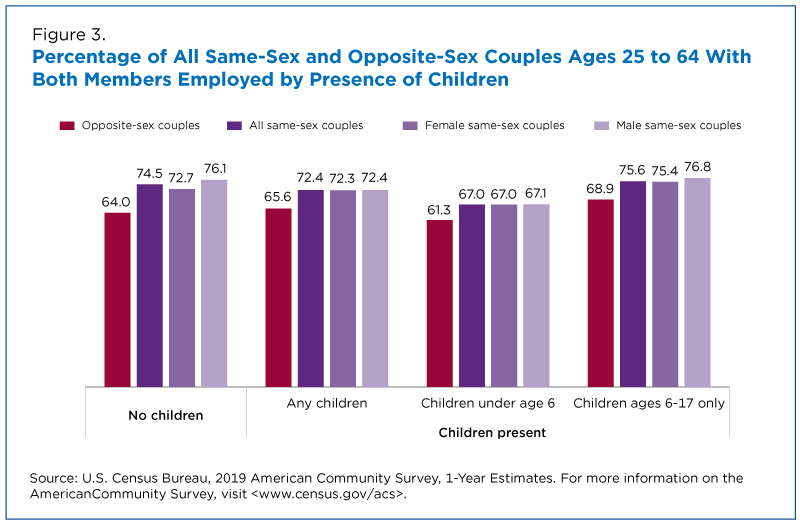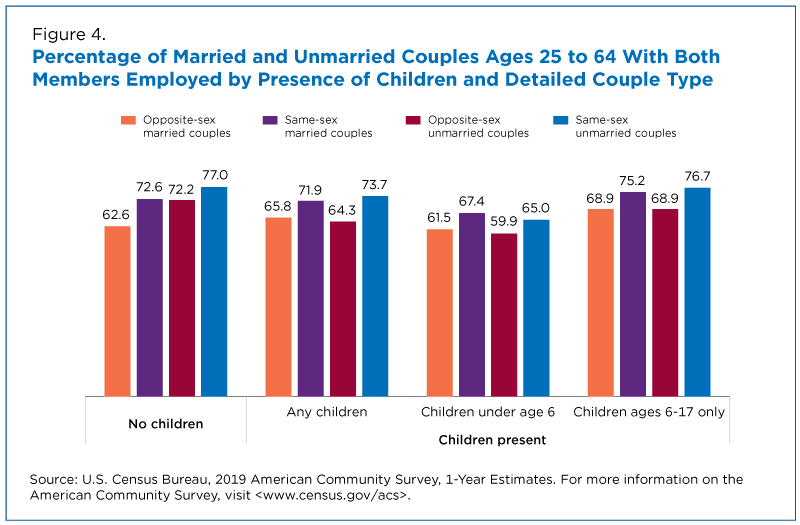Age, Children and Marital Status Don’t Account for Higher Rates of Employment Among Same-Sex Couples
Among all couples (married or unmarried), same-sex couples were more likely than opposite-sex couples to have both members employed in 2019 (65.1% and 51.1%, respectively), according to the Census Bureau’s American Community Survey (ACS).
Neither age, marriage, nor the presence of children fully explain why same-sex and opposite-sex couples differ when it comes to employment for both members of the couple.
Potential contributing factors include:
- Age. Same-sex couples tended to be younger than opposite-sex couples and less likely to have at least one member eligible for retirement. In fact, 26.0% of opposite-sex couples had at least one person 65 years or older compared with 15.6% of same-sex couples.
- Marital Status. Same-sex couples were more likely to be unmarried (58.0%) than opposite-sex couples (88.3%). Unmarried partners tended to have higher employment rates for both members than their married counterparts.
- Children. Previous analyses of the Current Population Survey showed a smaller share of same-sex couples had children (14.7%) than opposite-sex couples (37.8%). The presence of young children may influence a couple’s decision to have one parent stay home to care for the children.
The ACS does not identify all couples living together since it only collects information on each household member’s relationship to the householder and not about the relationships between all household members. Still, most couples do include the householder.
Age and Sex
Age has a strong association with whether or not a person is working or looking for work.
For example, older people may choose to retire and leave the labor force. Whether people are enrolled in school — high school, college or graduate school — may also affect a person’s decision to work.
To account for these potential age-related influences, we focused on couples between the ages of 25 to 64, ages when adults are most likely to work.
When we looked at this subset of couples, same-sex couples were still more likely to have both people employed: 74.1% of same-sex couples compared with only 64.9% of opposite-sex couples (Figure 1).
This pattern held true for all coupled households regardless of age, and also for couples with both members between 25 and 64 years old.
In addition, male same-sex couples were more likely to have both members employed (75.8%) than female same-sex couples (72.6%). Both male and female same-sex couples were more likely than opposite-sex couples to have both members employed.
Married or Unmarried
We know that same-sex couples are more likely than opposite-sex couples to be unmarried. This remains true even when looking only at couples between ages 25 to 64.
In addition, a higher percentage (69.5%) of unmarried couples than married couples (64.3%) had both members employed.
But married or not (Figure 2), a higher percentage of same-sex (72.4% and 76.6%, respectively) than opposite-sex (64.3% and 69.1%, respectively) couples had both partners employed. People in same-sex marriages were also more likely than their opposite-sex counterparts to work full-time and year-round.
Neither male nor female same-sex married couples were more likely than the other to have both spouses employed (73.3% and 71.6%, respectively). At the same time, both male and female married couples were more likely than opposite-sex married couples to have both spouses employed.
Young Children and Employment
While couples with children in the household (65.7%) were more likely than those without children (64.3%) to have both members employed, the age of children played a key role.
Couples with a child under age 6 in their household were less likely (61.3%) than couples with only older children present (69.0%) to have both members employed.
However, same-sex couples with children were more likely (72.4%) than opposite-sex couples (65.6%) to have both partners employed (Figure 3).
Even when we looked at the presence of young children, same-sex couples were more likely to have both members employed. In 2019, 67.0% of same-sex couples with young children (under age 6) had both members of the couple employed compared to 61.3% of opposite-sex couples with young children.
There were no differences between male and female same-sex couples with a child in their households. Both were just as likely to have both members working (72.4% for males and 72.3% for females).
This suggests that male same-sex couples’ higher employment rate for both members (when compared with female same-sex couples) may be, at least in part, because they are less likely than female couples to have children present.
Marital Status and the Presence of Children
In general, married couples with children were more likely (65.8%) than unmarried couples (64.5%) to have both members working.
This was also true when there were young children present — 61.5% of married couples with children under age 6 had both spouses working compared with 59.9% of unmarried couples.
When only older children were present, married and unmarried couples were equally (69.0%) as likely to have both partners working.
When comparing same-sex and opposite-sex couples, however, combining marital status and the presence of children still did not account for same-sex couples’ higher rates of employment.
Same-sex married couples with children were more likely (71.9%) than opposite-sex married couples with children (65.8%) to have both members employed (Figure 4).
The same was also true for unmarried partners — 73.7% of same-sex partners with children had both members employed, while only 64.3% of opposite-sex unmarried partners with children did.
Same-sex married couples with young children (under age 6) present were also more likely (67.4%) than opposite-sex married couples with young children (61.5%) to have both spouses working.
Neither age, marriage, nor the presence of children fully explain why same-sex and opposite-sex couples differ when it comes to employment for both members of the couple. Many factors influence choices about whether both partners work, and a modeled analysis would be required to disentangle those associations.
In 2019, we updated the way the ACS collects relationship to householder to improve estimates for coupled households and allow for easier exploration of the characteristics of those households.
Subscribe
Our email newsletter is sent out on the day we publish a story. Get an alert directly in your inbox to read, share and blog about our newest stories.
Contact our Public Information Office for media inquiries or interviews.










